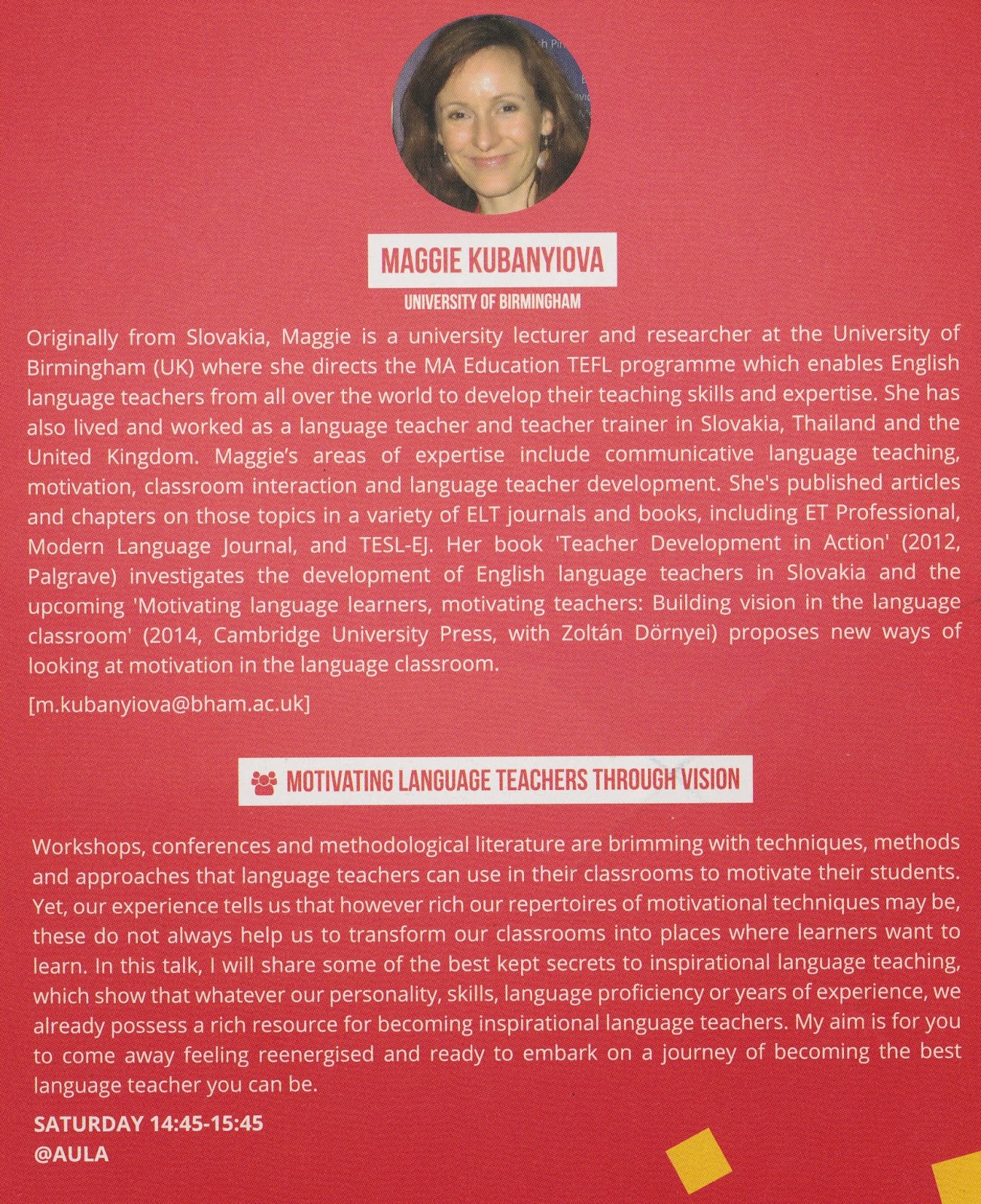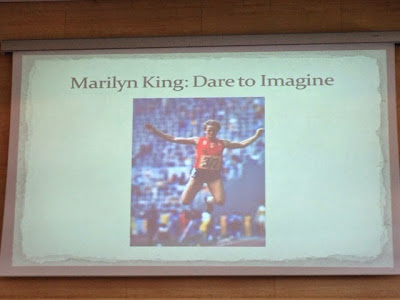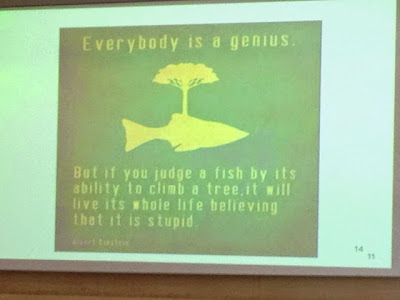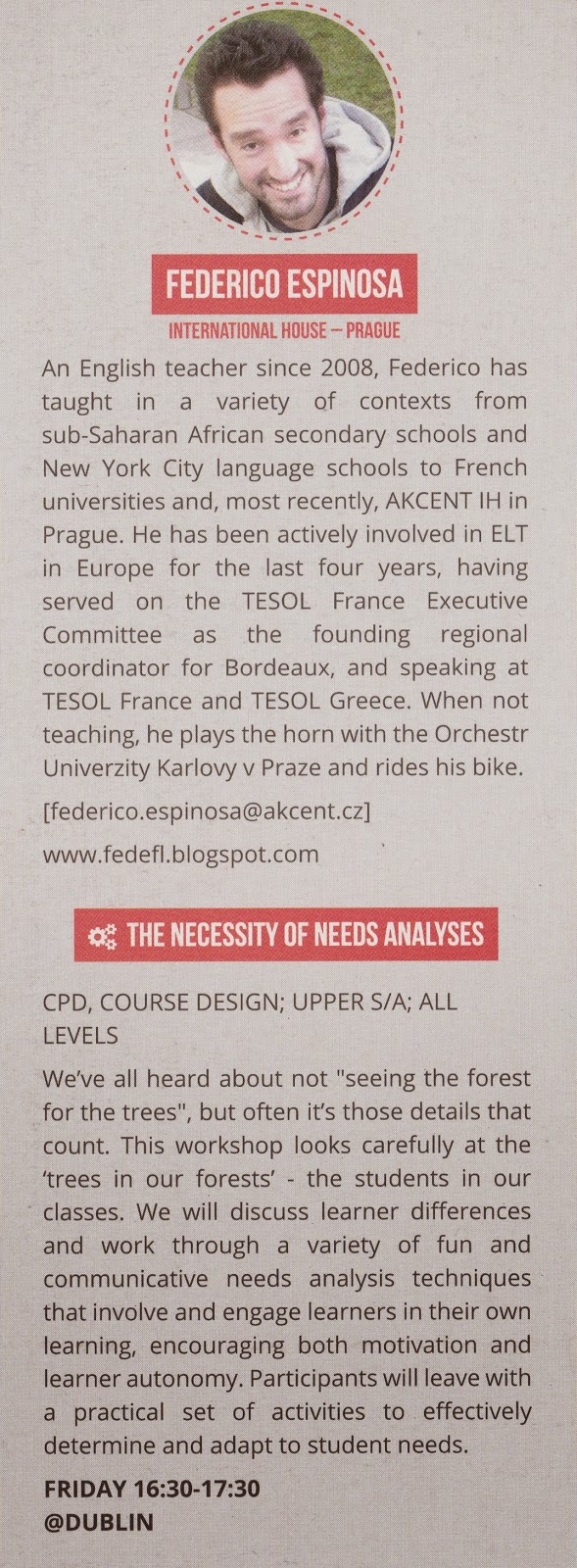I am in Slovakia for the Annual ELT Forum (ELTForum.sk) at
the Economics University of Bratislava. The theme this year is Building Blocks
of ELT – Language, Learner, Vision. It
is a phenomenally well-attended event with over 400 participants this year and
some fantastic plenary speakers.
The keynote speaker this year is none other than Professor
David Crystal, author of over 100 books, the Cambridge Encyclopedia of English
and innumerable blurbs, commentaries and notes on the English Language.
He begins his talk with a quick introduction and transitions
into an anecdote on the title of his talk. “The Future of Englishes” is apparently often misspelled. I guess language teachers just can’t handle the unusual form of the word, but fortunately the organizers of ELT Forum managed to get
it right.
He comments that ELT Forum is an organization that
“refreshes the parts that other organizations do not reach” and then launches
into an analysis of the phrase, which it turns out is an old Heineken slogan
from the 1970’s in England (Heineken’s original version was “Heineken refreshes the
parts that other beers do not reach”). This was a fantastically well-known
slogan that took a life of its own and is currently still recognizable,
as it has entered popular culture beyond the scope of Heineken advertising.
Apparently, Heineken’s slogan’s success is due to the humor
of the ads, using great situational comedy ads where lawn mowers came to life
and mowed the lawn themselves (in one example) thereby saving the day. Later however, Heineken started playing with the
words of the slogan making it “Heineken refreshes the p------s that other beers
do not reach”, replacing “parts” with other words.
The example he gives to illustrate this point is an
advertisement where Long John Silver becomes more and more ragged by his life on the high seas, until he is
saved by a beer, replacing the slogan with
“Heineken refreshes the PIRATES other beers do not reach”.
In a later ad, Long John Silver’s bird is the one rescued by the beer “Heineken
refreshes the PARROTS other beers do not reach”.
Still another ad portrayed a man in his car trying to describe a situation and struggling to express himself – and
suddenly he has a beer and a beautiful string of poetry comes out of his mouth “Heineken
refreshes the POETS other beers do not reach”, and so on and so forth.
So what’s the point of this slogan with regard to the topic of Englishes?
For this, Prof. Crystal tells the story of walking around with Japanese visitors in England looking for “authentic English” examples and
running into the “Heineken refreshes the PARROTS other beers do not reach”
slogan. His visitors, understandably, became quite confused.
“Heineken refresh parrot? What does it mean?!”
Suddenly the importance of cultural background rears its
head in the process of English education. Even with all the language skills
available to us, we need the context of culture to make sense of it. Something
that I, as an American, completely understand as I have been confused by
British humor in the past as well. It’s not a native/non-native distinction,
but rather a cultural issue.
This is how we have the issue of “Englishes”, the various
cultural forms of English that exist around the world.
So how do we keep track of this in a world where language
isn’t carefully monitored and recorded with statistics everywhere (or
anywhere!) it’s spoken?
The best guesses we have vary wildly, but 350 million to 450
million seems to be about right for native speakers of English, varying based
on all the pidgin forms of English around the world. As for the statistic of
English as a Second Language (where you are non-native, but live in a country
where English is the dominant language) there seem to be somewhere between 500
million to over 1 billion. There is no way to know. How do we count English
speakers in places like India, Nigeria, and so on? How much English fluency do
you need to be counted? 70%? 45%? Then we come
to English as a Foreign Language (where English has no official nor unofficial
status in the country you live in – most countries fall into this category) –
this again is completely unknown 400 million? 500 million? How do we count
English speakers in China? Brazil?
But in the end, it seems to shake out to at least 2 billion
English speakers of varying fluency somewhere in the world.
So, does this make English the current Lingua Franca? For how long? Latin has come
and gone, French has come and gone, and will English do the same? Will
technology replace the need for language skills? Probably, but Prof. Crystal
says not for 1,000 years or so (note: I disagree, in a world where applications
like
Word Lens exist already, I’d say we’re 100 years or less away from
functional simultaneous-language-translating hearing-aid type devices).
Either way, there are many English speakers out there, but
native speakers are outnumbered. By quite a bit actually – there are roughly 6
non-native speakers of English for every native.
So then who owns English in this world? England? The
USA? Everybody? Nobody? It seems that with globalization we’re increasingly
seeing people’s English being modified and changed by their experiences either
abroad or through online social media. Just as English colonials to the “New
World” began to use Americanisms such as “wigwam” and so on, currently we are
all adding and changing our own lexical and grammatical sets (I, for example,
regularly use “on holiday” now, and I no longer recoil at the expression “at
the weekend”, something completely alien to my American English upbringing).
In modern society where international couples are having
children and raising them in their common language of English, these children
are growing up learning “English as a Foreign Language” as their native
language. What will that do to the language?
So then we enter the discussion of why is English a global
language? According to interviews Prof. Crystal conducted for a radio show,
answers completely vary from “because it’s beautiful”, to "because it doesn’t have
grammar”, and “because it’s obvious”.
It may not have much in the way of morphology (word
endings), but then we have syntax (word order) coming out the wazoo and making
a mess for our learners. So is it really so obvious a choice?
Power ultimately determines the use of language. For a while, military power and the British Empire was the reason. Then came invention,
science and technology with England and the US leading scientific discovery in
the 1800’s. Currently, 80% of scientific articles are still published in
English. In the 1900s it came down to economic power and the banking systems of
Europe. Lastly comes cultural power, in a world where, in most parts of the
world, pop music on the radio is in English, the majority of the internet is in
English, and 85% of all the films in the world are in English.
In 1600, only 4 million people spoke English, most of them (not surprisingly) in England. Back then it was ridiculed and disregarded as an international
language. There wasn’t even much of a literary history – other than
Chaucer who it seems was difficult to understand even in 1600.
And then suddenly in 1592, English crosses the Atlantic and
sets up shop in what is now the USA. Also, in the 1590s Shakespeare started
writing poems and plays. Suddenly, not long after 1600, England had launched
its literary tradition, which continued and branched, and 400 years later 4
million became 2 billion.
But anyway, the question of this keynote talk is on the future of English. Sorry David, Englishes. So what will
happen with all the various Englishes around the world?
The United Nations has half a dozen official languages (English,
Spanish, French, Russian, Mandarin Chinese, Arabic) and yet English is the one
most commonly used to communicate in the corridors around the place. The world
has united around the language and adopted it as the political, business and
cultural language.
What about places like Nigeria, where English is the
unifying language of 450 ethnic and language groups? At the end of colonial
rule it was deemed best to keep English (or French, or Portuguese…) as an official
language in many such countries for stability to avoid political tensions
between ethnic groups which had arbitrarily been thrown into sovereignty together. Yet, in an effort to move away from “colonial English”
new forms of English developed. Liberian English (it can be fine-o), Ghanaian
English, Guinean French, and many others emerged to express the culture of the
newly formed nations. New culturally relevant words emerged and 50 years or 60
years later the language is a whole different creature. 10,000 words only used
in the South Africa region. 15,000 words only used in Jamaican and surrounding islands, and that's just two of these Englishes!
How does cultural knowledge work here? How do we, as
non-South-African English speakers interpret signs such as “Robots Ahead”?
Would we picture an Isaac Asimov novel, or correctly guess that there is a
stoplight (traffic light) ahead?
It turns out about 80% of English does not relate lexically to
the original Anglo-Saxon roots. As a vacuum cleaner language, it has sucked up
words from every language it has ever touched. This is how we find familiar
cognates in many other (primarily European). Lexis varies
greatly, though grammar tends to stay the same across Englishes. There are a
few exceptions (Indian English incorporates continuous forms “-ing” on
traditionally stative verbs (I am thinking, I am knowing, I am wanting…etc).
Even McDonald’s has entered the game with its “I’m loving it” slogan that
should prescriptively be “I love it”.
Accents are equally mixed nowadays. The BBC, The British
Council, Language Schools, etc. no longer stick to Received Pronunciation (that
accent you think of when you think of a classical British accent from the
1960’s) but rather represent any number of mixtures of accents.
As for cultural knowledge, even in non-English speaking countries we run into new
phrases and culturally relevant examples that do not cross borders. Czech
English certainly has this with phrases such as “the nature” to describe the
notion of the countryside/the outdoors/forest/woods/mountains/mushroom
hunting/bird watching, all rolled into one. Names of political parties, names of local
landmarks, local foods get peppered into English and even with perfect grammar,
perfect syntax, perfect morphology, a non-Czech English speaker could still get
lost at the phrase "Let's meet up at Jiřího z Poděbrad and get a beer and some hermelin at Riegrovy Sady, then check out the new Černy exhibit at DOX".
So how does this affect English teaching?
When it comes to production, we can’t help but teach our own accent
and language set to our students. However, for receptive skills it is necessary
that students be trained to identify and understand other varieties of English, and develop the cognitive skills to eke out meaning from context for unfamiliar or unnaturally used words. They are likely to find some forms of English by traveling or getting on the Internet,
so it is important to work on these. Authentic English sources of non-native
speaker English are readily available online and one source he listed was
IDEA (International Dialect English Archive).
The remainder of the talk was scheduled for a question and
answer session.
The first question was about ELF (English as a Lingua
Franca) the idea of teaching a form of English that is intentionally neutral
and consolidated to form a general dialect that transcends individual language
differences.
Prof. Crystal criticized the ELF movement as being
premature, trying to promote a language that has not been thoroughly researched
and found. It overgeneralizes and breaks down language in a way that makes it
easier to learn. An example is the loss of countable/uncountable distinctions
that ELF proponents claim do not exist in many international forms of English.
This is a decision, among others, that corpus data and research simply do not support.
The second question had to do with intergenerational
modifications to language. For example “gay”, “wicked”, and other words that
have changed meaning significantly in our lifetimes.
David gives examples of some issues he has with these words
as well as with pronunciation within his family: “schedule” (UK starting with “shed”,
US starting with “sked”) being pronounced different depending on if he’s
speaking with his wife or his children. However, he states that the Internet
has changed things in such a way that the impact of generational differences
are being lost as standard definitions and pronunciations more quickly reach the general audience.
The third question asked if we would reach a point where
within English we would have such drastically different pronunciations that we
would not understand each other. Prof. Crystal says that we are already there
and it happens daily with current English. This is nothing new.
The final question brought up the issue of non-native
teachers being discriminated by educational institutions around the world.
Prof. Crystal agreed that this is an absurd distinction to
draw, and that many examining boards and schools are changing mentalities
nowadays. He has done research in the past on non-native proficiency levels and
found that many of the higher level non-native speakers still spoke quite a bit
better than even native speakers (I can attest to this, having picked up a few key vocabulary words including "hendiadys" from my proficiency level students). The only areas that non-natives seem to really be at a deficit are apparently nursery
rhymes and making love – hardly high frequency in a standard EFL classroom.


































